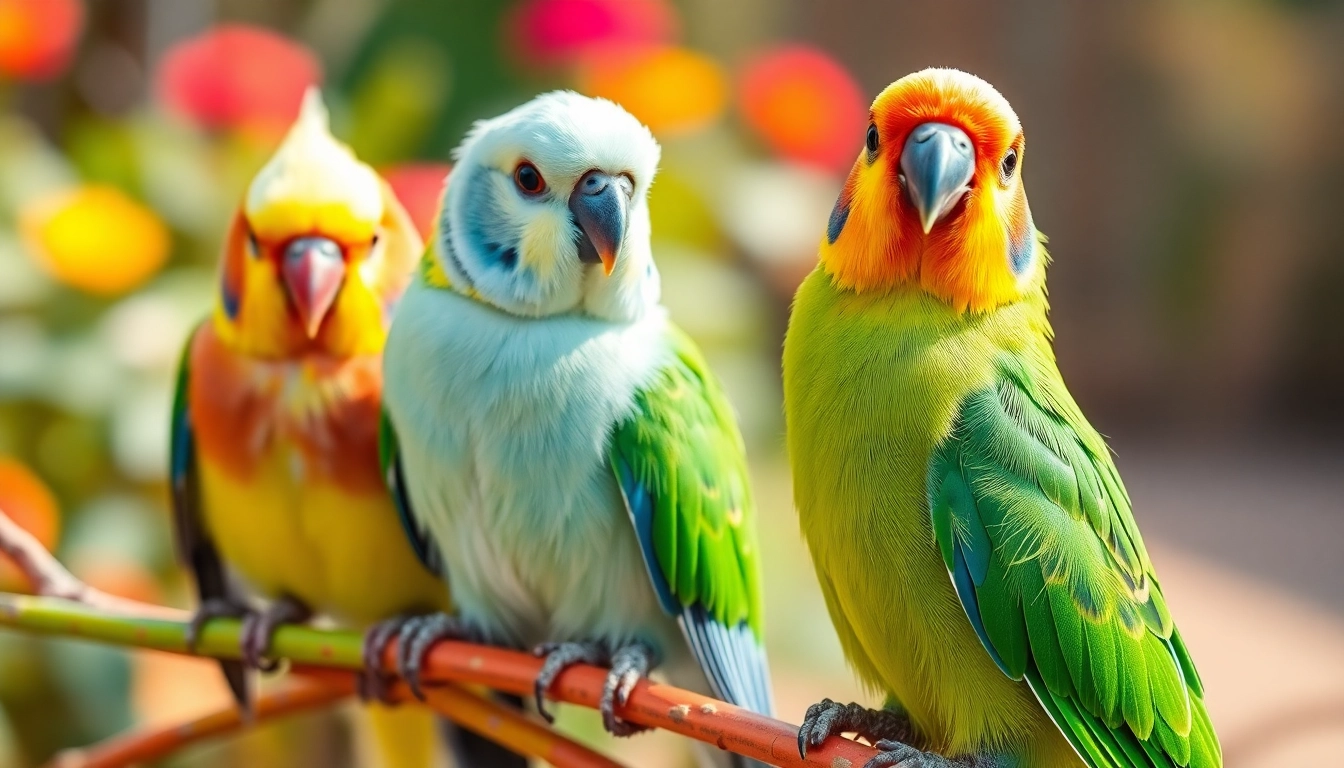Understanding Different Types of Pet Birds: Species, Size, and Temperament
When considering adding a pet bird to your home, one of the most important steps is understanding the diverse range of species available. Each bird species brings its unique characteristics, care requirements, and temperaments. A well-informed choice ensures a harmonious relationship and a fulfilling experience with your avian companion. For those venturing into the world of pet birds for the first time, it’s essential to explore popular species suitable for beginners, assess temperament traits suitable for shy or busy owners, and understand longevity and care considerations. This comprehensive guide aims to equip you with in-depth knowledge to select the perfect pet bird tailored to your lifestyle.
Learn more about pet birds and their care throughout this detailed exploration.
Popular Pet Bird Species for Beginners
Embarking on your avian journey often begins with choosing species known for their manageable care requirements, friendly demeanor, and adaptability. The following are some of the most recommended pet birds for those new to bird ownership:
- Budgerigars (Budgies): Among the most popular and affordable, budgerigars are small, intelligent, and surprisingly interactive. They typically live 5 to 10 years, making them suitable for first-time owners. Their playful nature allows them to learn tricks and mimic sounds, engaging owners in ongoing enrichment activities.
- Cockatiels: Recognized by their distinctive crests and bright personalities, cockatiels are friendly and affectionate. They thrive on social interaction and can form strong bonds with their owners, often enjoying head scratches and whistling along.
- Canaries: Known for their beautiful singing and vibrant plumage, canaries are ideal for owners who appreciate a quieter pet. They require less handling but reward owners with their melodious tunes, enhancing household ambiance.
- Finches: Active and social, finches do best in pairs or groups. They are hardy, easy to care for, and ideal for individuals with limited space. Their lively behaviors and color variety add a dynamic presence to any room.
Research indicates that these species tend to adapt well to domestic environments, have moderate care needs, and exhibit friendly behaviors—key factors for beginners. Studies have also shown that owners of these species report high levels of satisfaction and meaningful interactions, reinforcing their suitability for first-time bird owners.
What Species Suit Shyer or Busy Owners
Different bird species are better suited to owners with specific lifestyles. Those who are shy or prefer minimal interaction may opt for self-reliant and calm species, while busy owners often need low-maintenance birds that can tolerate being alone. Here’s an in-depth look at species tailored to these needs:
Species Suitable for Shyer Owners
- Poicephalus Parrots: Shyer and less demanding, these parrots tend to be more reserved but still enjoy quiet companionship. They are capable of entertaining themselves and require less frequent handling, making them ideal for owners who prefer a more laid-back interaction.
- Lovebirds: Though social, lovebirds can be discreet and form close bonds with their owners. They thrive in calm environments and often display affectionate behavior without excessive noise.
Species Suitable for Busy or Less Hands-On Owners
- Finches: As social but independent birds, finches do not demand extensive interaction. They are well-suited for owners who can’t dedicate hours daily but wish to enjoy bird activities visually.
- Budgies: While playful, budgerigars are also resilient and can tolerate periods of solitude. They require regular socialization for optimal well-being but are fairly adaptable to routines.
Understanding these behavioral and environmental preferences is crucial in selecting a species that aligns with your personality and schedule. Studies reveal that matching a bird’s temperament to the owner’s lifestyle significantly improves overall satisfaction and reduces stress-related behaviors in the bird.
Long-Lived Pet Birds and Care Considerations
One of the most impactful aspects of choosing a pet bird is understanding their lifespan and the associated commitment. Some species of birds can live decades, making them lifelong companions, while others may have shorter lives. Awareness of these longevity expectations guides responsible ownership and ongoing care planning.
Species with Extended Lifespans
- Hyacinth Macaws: These magnificent parrots can live up to 50 years or more when properly cared for, making them a long-term commitment. They require large, enriching cages, specialized diets, and social interaction.
- Cockatoos: Known for their intelligence and affectionate nature, cockatoos can live 30 to 70 years, depending on species. Their care involves mental stimulation and social grooming.
- Lovebirds: Typically living 10 to 20 years, lovebirds are manageable lifetime pets with consistent diet and social needs.
Care Considerations for Longevity
Long-lived birds demand diligent daily care — including proper diet, mental stimulation, cage hygiene, and regular veterinary checkups. Preventative health measures and pest control help avoid common issues such as feather plucking, respiratory infections, or nutritional deficiencies. Advanced planning ensures that potential financial and emotional commitments align with your capacity to provide long-term care.
Leading avian veterinarians agree that longevity is not just about the species but also about the quality of care, environment, and social interaction provided. Establishing routines, providing enrichment, and monitoring health are fundamental to ensuring a happy, healthy lifespan.
Essential Care and Maintenance for Pet Birds
Feeding, Cage Setup, and Health Checks
Nutritional needs vary across species, but a balanced diet typically comprises high-quality seeds, pellets, fresh fruits, and vegetables. Avoiding toxic foods such as avocado or chocolate is critical. Proper cage setup includes adequate space for flying or hopping, perches of varying diameters to promote foot health, and toys that stimulate both mental and physical activity.
Routine health checks are vital. Regular veterinary visits, observing for signs of illness (like feather loss, lethargy, or abnormal droppings), and maintaining cleanliness help catch issues early. In addition to dietary care, providing clean water daily and ensuring proper cage hygiene reduce disease risks.
Socialization and Enrichment Activities
Pet birds are inherently social creatures. Providing daily interaction, whether through training, talking, or simple companionship, enhances their mental well-being. Enrichment involves including toys, foraging activities, and opportunities for flight or climbing, which prevent boredom and destructive behaviors.
Studies suggest that enriched environments reduce stress and improve longevity, especially in intelligent species like parrots. Rotating toys and introducing new stimuli keep the bird mentally engaged.
Common Health Issues and When to Consult an Avian Vet
Common health problems include feather plucking, obesity, respiratory infections, and nutritional deficiencies. Early detection relies on behavioral and physical cues—clucking less, sitting at the bottom of the cage, or changes in vocalization. Professional veterinary consultation is essential when symptoms persist or worsen. Regular health screening, including blood tests and wing trims, supports long-term health.
Choosing the Right Pet Bird for Your Lifestyle and Home
Cost, Maintenance Level, and Lifespan Expectations
Financial considerations encompass initial purchase or adoption fees, cage setup, veterinary care, diet, toys, and other accessories. Budget-friendly species such as budgerigars and finches often have lower costs, while larger parrots require significant investment over their lifespan.
Maintenance level varies from minimal—like canaries, which need basic environmental conditions—to high-maintenance species like macaws, demanding specialized diets and social interaction. Your choice should reflect your time availability, financial capacity, and commitment readiness.
Space Requirements and Interaction Needs
Space is a critical factor. Smaller birds like finches or budgerigars require less room but benefit from larger cages that allow flight. Larger parrots, such as macaws or cockatoos, necessitate spacious cages and dedicated areas for daily exercise. Interaction needs depend on the species—species like cockatoos thrive on social bonding, while finches are less social with owners but enjoy flock environments.
Safety Tips and Responsible Ownership
Ensuring a safe environment involves safeguarding toxic plants, fumes, or household items that could harm your bird. Window and ceiling fan safeguards, supervision during free flight, and secure cages are mandatory. Responsible ownership also encompasses regular training and socialization, keeping the bird mentally and physically stimulated, and committing to a lifetime of care.
Training and Bonding with Your Pet Birds
Building Trust Through Routine and Care
Establishing a predictable routine enhances trust. Consistent feeding times, daily interaction, and gentle handling foster a secure environment for your bird. Using positive reinforcement methods, such as treats and praise, encourages desired behaviors.
Handling and Training Techniques for Different Birds
Training approaches differ across species. Parrots respond well to clicker training and step-by-step commands, while finches benefit from environmental enrichment rather than direct handling. Gradual desensitization to handling reduces stress, making interactions more enjoyable for both owner and bird.
Encouraging Communication and Learning Bird Songs
Many pet birds can learn to mimic sounds or whistles. Repetition, consistency, and rewarding attempts reinforce learning. Playing recordings of bird songs can stimulate vocalization, enriching your bird’s environment. Such activities strengthen bonds and create a lively household ambiance.
Resources and Community for Pet Bird Enthusiasts
Local Bird Clubs and Adoption Centers
Joining bird clubs and visiting local shelters or adoption centers connects owners with experienced enthusiasts and provides access to healthy, socialized birds. These communities often offer workshops, support, and educational resources that bolster responsible care.
Reliable Breeders and Supplies
Choosing reputable breeders ensures healthy, genetically sound birds. Supplies like cages, toys, and dietary products should come from trusted sources to meet high-quality standards. Doing thorough research minimizes risks of disease and poor health.
Online Forums and Support Networks
Digital communities provide platforms for exchanging advice, troubleshooting issues, and sharing success stories. Engaging with veteran bird owners deepens understanding and fosters continuous learning.



